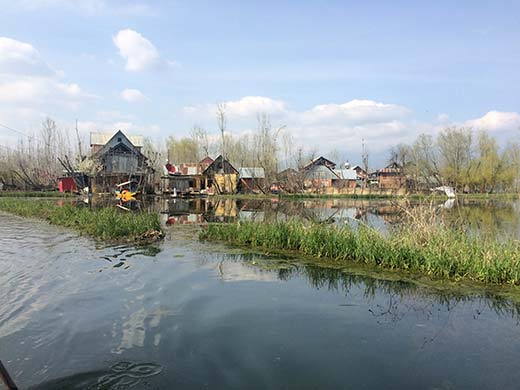Nadur has been relished in Kashmir for centuries. However, there has been a decline in its quality and production in recent years, Syed Asma reports.

Nelumbo nucifera, Nadur in local parlance, that grows in shallow parts of water bodies like ponds and lakes is a highly liked ingredient in Kashmiri cuisine. However, both production and quality of the Nelumbo in the valley, experts say, is on the decline as a direct result of rising water pollution and shrinking water bodies.
Nadur, or lotus stem, is used in many Kashmiri dishes. In many Asian countries, almost every part of this plant is consumed but in Valley only the stem and its seed are in demand. The distinctive dried seed heads resemble the spouts of watering cans.
Lotus stems have been found to be rich in dietary fiber, vitamin C, potassium, thiamin, riboflavin, vitamin B6, phosphorus, copper, and manganese, while very low in saturated fat.
The production of lotus stem in Kashmir valley, over the years has been on decline besides suffering a marked deterioration in quality.
“For years I have earned a living from collecting Nadur, enough to feed my family but the falling production and the shrinking lake can leave me without a livelihood,” says Abdul Ahad, who collects lotus stem from the Anchar Lake.
Those who cultivate the plant are also a worried lot. Bilal Ahmed cultivates lotus plant in Nigeen Lake. He says untimely rains destroyed half of the Nadur crop last year.
“Last year’s heavy rains and floods destroyed the Nadur crop and affected this year’s production,” he said.
Nadur cultivators and collectors foresee a spike in its prices this season.
Lotus stem are sold in 1.75 kilogram bundles. A single Nadir bundle will cost anywhere between Rs 130 to Rs 170 depending on the origin and girth of the produce.
“It (Nadur) is becoming very expensive. A few days back I purchased a bundle for Rs 500. No doubt these were of good girth and quality but still Rs 500 for a bundle is a lot,” said Zamrooda, a housewife living in downtown Srinagar. However, cultivators and other people associated with the trade say that the price is justified as “lots of expenses and energy go into the cultivation of this vegetable.”
 This crop needs almost as much care as rowing other vegetables. Locally produced lotus stem is available from September to February. During these months, Riyaz Ahmed, a cultivator of Anchar says that in these months Nadur is collected and sold on daily basis.
This crop needs almost as much care as rowing other vegetables. Locally produced lotus stem is available from September to February. During these months, Riyaz Ahmed, a cultivator of Anchar says that in these months Nadur is collected and sold on daily basis.
From March to May, weeds are removed from the water body. The crop can be badly affected by if there is a delay in de-weeding or if it is not done properly, says Riyaz. Different fast growing algae are a threat to the plant.
“During May and June, it is not possible to extract lotus stem, its leaves and flowers cover the whole surface,” he adds.
Lotus stem is extracted by cutting at the roots and a worker has to wade in the water for hours to get a few kilos. It is more laborious to extract during winter when the water is chilly, says Riyaz.
The polluted water usually causes skin allergies in workers. The entire business is connected to water from collecting to cleaning.

In Anchar lake, workers wade in the water to extract lotus stem. However, when the water levels are high as in Dal lake, workers use Kov – a long wooden pole with a sharp S-shaped iron hook knife attached to the bottom, allowing them to extract the edible underground stem without wading into the water.
Nadur growers say only few workers can use the Kov to extract lotus stem as it needs a lot of practice, patience and guess work which only comes with experience.
They say many precautions are to be taken while extracting Nadur.
“A lotus stem when cut should not be cut along with root, otherwise it will affect the crop as a whole and of the coming years also,” Riyaz says.
The plant is a perennial one and seeds or saplings are not needed every year. The roots of the plant can produce Nadur for years, so need good care, says Bilal. New seeds are sown only to increase the production, if needed.
Almost all major lakes in Kashmir have lotus plants and the stem is extracted from these but the major supply comes from Dal and Anchar lakes.
An untrained eye, would not find much difference between the two except for a slight colour variation. The Nadur from Dal lake is whitish with dull black spots while the Anchar Nadur is white in colour.
“There is a large difference between Anchar and Dal lotus stems. The ones from the Dal Lake taste much better,” Zamrooda says.
Lotus stem, apart from its use in Kashmiri dishes is also widely consumed as snacks. Fried lotus stem called Nadir Monji locally, are available across Srinagar and other towns of the valley. Abdul Ahad who sells Nadir Monji at Hazratbal says, “I am in this business for the last decade now and I never witnessed any loss in it, in fact the sales go up every year.”
As the demand for Nadur in the valley outstrips the supply, huge quantities of lotus stem are brought to valley from Jammu. However, the vegetable vendors say, people do not prefer these.
When vegetable sellers started to import it from Jammu, the prices of the local produce went down. “People were initially carried away by the less price of Jammu Nadru but day by day the percentage of people purchasing them is decreasing,” says wholesale vegetable dealer Mohammed Sultan.















